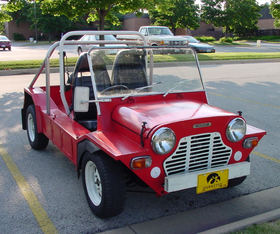| Mini Moke | |
|---|---|
 | |
| Overview | |
| Manufacturer | |
| Also called | |
| Production | 1964–1993 |
| Assembly |
|
| Designer | Sir Alec Issigonis John Sheppard |
| Body and chassis | |
| Class | Utility vehicle[5] |
| Body style |
|
| Layout | FF layout |
| Related | MOKE revival |
| Powertrain | |
| Engine | |
| Transmission | 4-speed manual |
| Dimensions | |
| Wheelbase | 2,020 mm (79.5 in)[6] |
| Length | 3,050 mm (120.1 in) |
| Width | 1,300 mm (51.2 in) |
| Height | 1,400 mm (55.1 in)(with cloth roof and windshield raised) |
| Kerb weight | |
The Mini Moke is a small, front-wheel-drive utility and recreational convertible, conceived and manufactured as a lightweight military vehicle by British Motor Corporation (BMC), and subsequently marketed for civilian use under the Austin, Morris, Leyland, and Moke brands. The name "Mini Moke" combines mini with moke, an archaic term for a mule.[7][8][9][10] The Moke is known for its simple, straightforward, doorless design; and for its adaptability.
BMC's Cowley plant started building Mokes in January 1964, with 14,518 produced in the UK between 1964 and 1968; 26,000 were manufactured in Australia between 1966 and 1981; and 10,000 in Portugal between 1980 and 1993 when, after a nearly 30-year run, production ended.[11][12][13][14]
In 2013, in a joint venture with Jaguar Land Rover, Chinese automaker Chery Automobile started production in China of a new car called Moke.[15][16] This evocation of the design is assembled and distributed by a number of companies in several countries including England, France, and the US, although ownership of the Moke trademark is disputed.[17]
- ^ "1966 BMC Mini Moke (military version)" (brochure). BMC. 15 July 2012. Retrieved 30 April 2013 – via flickr.com.
- ^ Leyland Moke brochure, Leyland Australia, July 1975
- ^ "African Mokes". baragwanath.co.za. Retrieved 5 February 2011.
- ^ "Moke Register". baragwanath.co.za. Retrieved 28 June 2015.
- ^ "Mini Moke". australiafor everyone.com.au. Archived from the original on 30 March 2012. Retrieved 23 August 2012.
- ^ Mini-Moke Driver's Handbook Supplement.
- ^ Rees, Chris (2003). Complete Classic Mini 1959–2000. Motor Racing. ISBN 1-899870-60-1.
- ^ Nuttall, Tim (December 1989). Mini Moke 1964–1989. Brooklands Books. ISBN 1-870642-94-5.
- ^ Cite error: The named reference
clarke3was invoked but never defined (see the help page). - ^
 The dictionary definition of moke at Wiktionary
The dictionary definition of moke at Wiktionary
- ^ Rees, Chris (2003). Complete Classic Mini 1959–2000. Motor Racing. ISBN 1-899870-60-1.
- ^ Hirst, Henry (30 July 2021). "Classic Mini: Essential Transport". Character-19 – via Google Books.
- ^ Mainland, Keith (31 July 2015). Classic Mini Specials and Moke. Ramsbury, Wiltshire: Crowood. ISBN 9781785000027. Retrieved 19 July 2023.
The first batch of ten Mokes was built in January 1964, badged Austin and sent to Papua New Guinea and Singapore. The next batch of Austin Mokes was built in June and Morris-badged Mokes first appeared in July.
- ^ Chapman, Giles (30 April 2019). "A World of Different Minis". Mini: 60 Years. Beverly, Massachusetts: Motorbooks. p. 73. ISBN 9780760363997. Retrieved 19 July 2023.
In October 1968, British manufacture ended after 14,518 had been built (all but 1,467 exported), and the entire Moke tooling was shipped to Sydney, Australia.
- ^ "Chinese automaker Chery restarts Moke production". hemmings.com. Retrieved 23 September 2022.
- ^ "CHINA: Chery JV plans Mini Moke revival". JustAuto.com. 10 December 2012. Retrieved 10 July 2023.
- ^ Jahner, Kyle (9 May 2024). "Dueling 'Moke' Sellers Tell 4th Cir. Trademark Isn't Generic". news.bloomberglaw.com. Retrieved 26 May 2024.